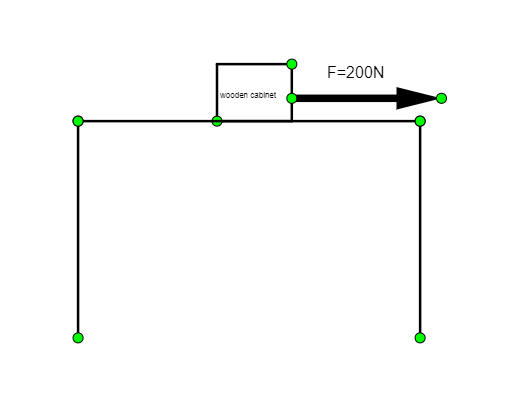
Using a horizontal force of 200N, we intend to move a wooden cabinet across a floor at a constant velocity. What is the friction force that will exert on the cabinet?
Answer
580.5k+ views
Hint: For a body to move with a constant velocity across the floor, the net external force ${{F}_{ext}}$ on the body must be zero. ${{F}_{ext}}$ is the sum of force applied and frictional force on the cabinet. So the force of friction should be equal to the force applied on the cabinet for it to move at a constant velocity.
Complete step by step answer:

We know that a horizontal force of 200N is applied on a wooden cabinet. For a body to move with a constant velocity across the floor, the net external force ${{F}_{ext}}$ on the body must be zero.
${{F}_{ext}}=F+{{F}_{friction}}$, where F is the force applied on the body and ${{F}_{friction}}$is the frictional force.
So the sum of force applied and frictional force should be zero.
$\Rightarrow F+{{F}_{friction}}=0$
$\therefore {{F}_{friction}}=200N$
Therefore for the body to move with a constant velocity under the influence of the applied horizontal force of 200N, a friction of 200N must be exerted on the cabinet.
Additional information:
The coefficient of friction demonstrates the relation between two objects and the normal reaction force between the objects. It is the ratio between frictional force and normal reaction force that gives us a coefficient of friction. There are two types of coefficient of friction. They are the coefficient of static friction and the coefficient of Dynamic friction. Frictional force between two objects when both the objects are at rest is indicated by coefficient of static friction. Frictional force between two objects when either one body or both the bodies are in motion is indicated by coefficient of dynamic friction.
Note:
The coefficient of friction is dimensionless as it is the ratio between two forces. Normal reaction force is always opposite to the direction in which the mass of the system acts. Object on a rough surface is set in motion only if the force applied on it overcomes the frictional force between object and the surface.
Complete step by step answer:

We know that a horizontal force of 200N is applied on a wooden cabinet. For a body to move with a constant velocity across the floor, the net external force ${{F}_{ext}}$ on the body must be zero.
${{F}_{ext}}=F+{{F}_{friction}}$, where F is the force applied on the body and ${{F}_{friction}}$is the frictional force.
So the sum of force applied and frictional force should be zero.
$\Rightarrow F+{{F}_{friction}}=0$
$\therefore {{F}_{friction}}=200N$
Therefore for the body to move with a constant velocity under the influence of the applied horizontal force of 200N, a friction of 200N must be exerted on the cabinet.
Additional information:
The coefficient of friction demonstrates the relation between two objects and the normal reaction force between the objects. It is the ratio between frictional force and normal reaction force that gives us a coefficient of friction. There are two types of coefficient of friction. They are the coefficient of static friction and the coefficient of Dynamic friction. Frictional force between two objects when both the objects are at rest is indicated by coefficient of static friction. Frictional force between two objects when either one body or both the bodies are in motion is indicated by coefficient of dynamic friction.
Note:
The coefficient of friction is dimensionless as it is the ratio between two forces. Normal reaction force is always opposite to the direction in which the mass of the system acts. Object on a rough surface is set in motion only if the force applied on it overcomes the frictional force between object and the surface.
Recently Updated Pages
Why are manures considered better than fertilizers class 11 biology CBSE

Find the coordinates of the midpoint of the line segment class 11 maths CBSE

Distinguish between static friction limiting friction class 11 physics CBSE

The Chairman of the constituent Assembly was A Jawaharlal class 11 social science CBSE

The first National Commission on Labour NCL submitted class 11 social science CBSE

Number of all subshell of n + l 7 is A 4 B 5 C 6 D class 11 chemistry CBSE

Trending doubts
What is meant by exothermic and endothermic reactions class 11 chemistry CBSE

10 examples of friction in our daily life

One Metric ton is equal to kg A 10000 B 1000 C 100 class 11 physics CBSE

1 Quintal is equal to a 110 kg b 10 kg c 100kg d 1000 class 11 physics CBSE

Difference Between Prokaryotic Cells and Eukaryotic Cells

What are Quantum numbers Explain the quantum number class 11 chemistry CBSE




